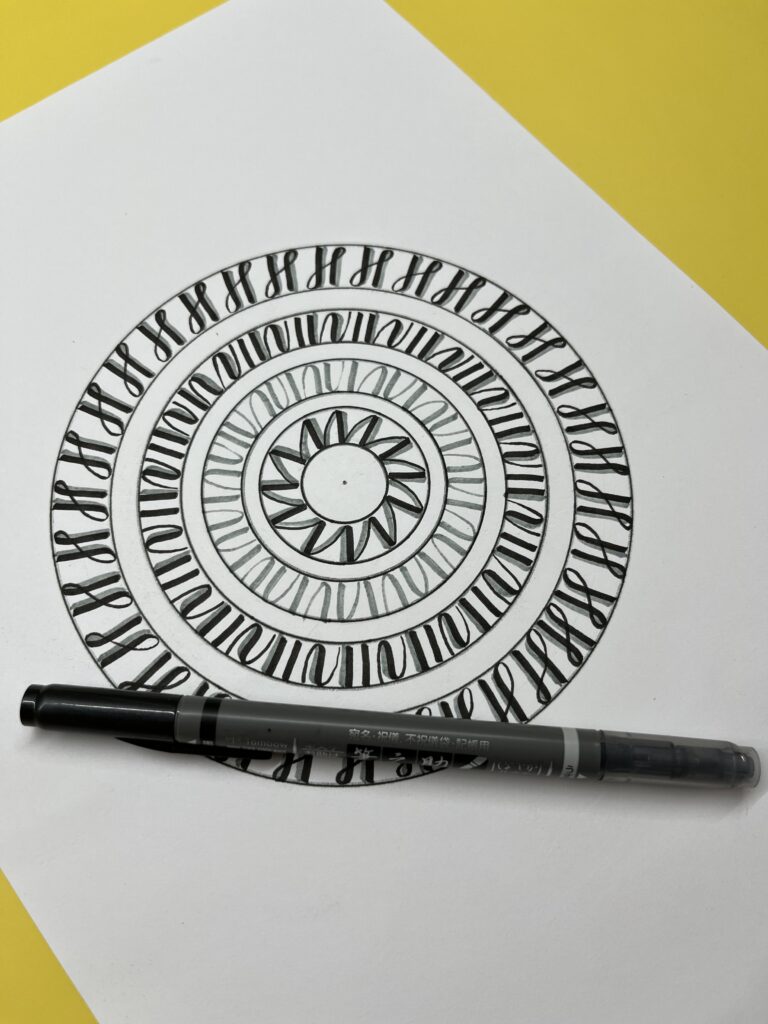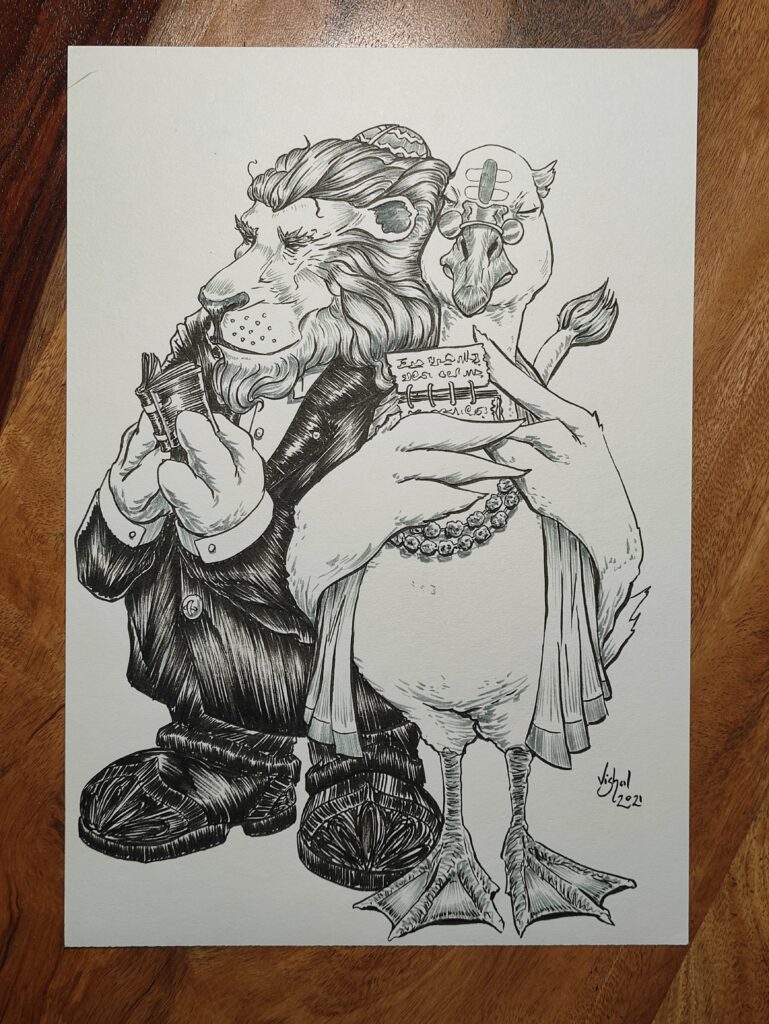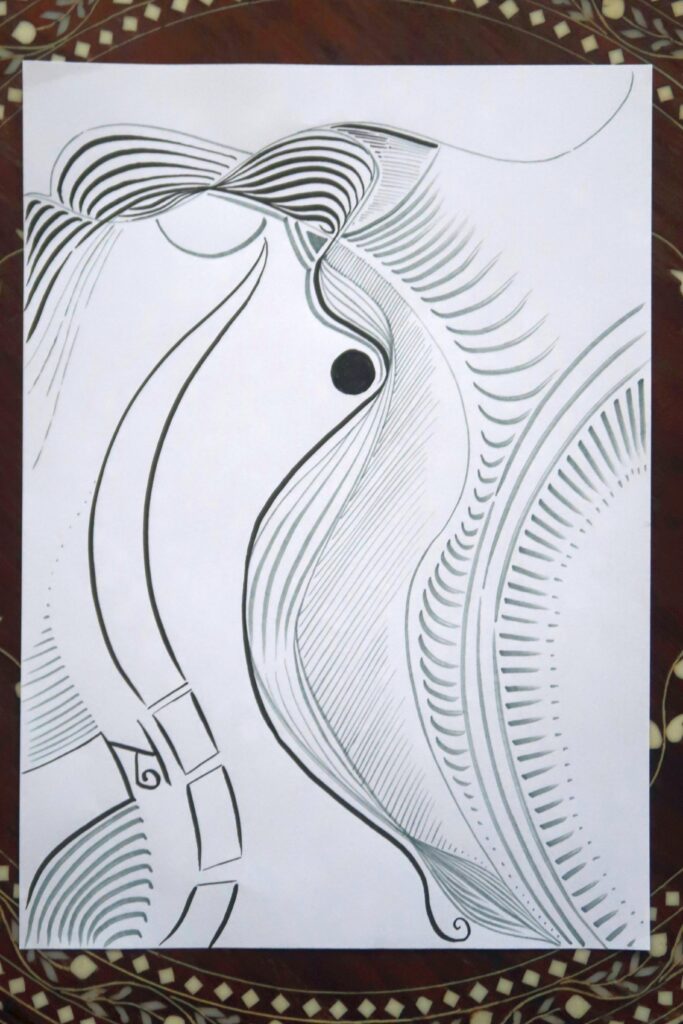We test Tombow’s dual tip Fudenosuke calligraphy pen. It’s a great introduction to flexible-nib felt pens for beginners and the more seasoned letterer, artist or casual stationery lover. Is it a dual brush pen or more of a dual calligraphy pen? We put it through its paces to find out.
Reviewing the Tombow Fudenosuke Dual Brush Pens
Vishal: Welcome to Stationary Test Drive by Inky Memo. Today we are going to be looking at the Tombow Fudenosuke calligraphy pen double ended but before that let’s introduce ourselves. My name is Vishal.
Samir: I am Samir.
Minjal: This is Minjal.
Vishal: And you can find us online in several places but let’s talk about some of the things we’re working on. I am nearly at the end of a long journey in digital art doing 100 portraits digitally, you can find that online and we’ll link to all these in the description and tell you more at the end of the video. Minjal?
Minjal: Samir and I are setting up the shop page on inkymemo.com, our website, for you guys to buy our products.
Vishal: Okay, so I think that’s enough of that out of the way, let’s talk about what we are test driving today which is this Tombow Fudenosuke. I hope I am saying that right, calligraphy pen made in Japan, very clearly double-ended. It has a black end and a grey end and since this is stationery test drive you can see three examples of things that we have done using only this pen. So ladies first, let’s start with the calligraphy which looks wonderful and makes a nice centerpiece literally for our video. Minjal tell us about your experience with this wonderful and strange pen.
Calligraphy Mandala with the Tombow Fudenosuke Dual Brush Pen

Minjal: Those familiar with brush lettering would know that these are the basic strokes or the foundation strokes of brush lettering. I’ve been using the Tombow pen for some time now and within this pen I have my preference – I prefer the hard tip which is the grey side, I believe, not the black one, right?
Samir: I felt that the black was the hard side?
Minjal: So yes we’re a little confused about, one of the sides is supposed to be the hard tip and one is softer.
Vishal: This is the internet’s yellow and blue dress all over again!
Minjal: So you’ll should check and maybe let us know in the comments!
Samir: I think as we’ve been testing out various pieces of stationery it’s also kind of becoming apparent that a lot of our reaction to it is based on the kind of work we do and the way we make a mark. Yeah, the main difference being Vishal and I maybe come from more of a illustration perspective and therefore we’re more about the kind of the sketchy line or kind of getting the shape down in general whereas Minjal comes from a calligraphy perspective where you are trying to write in a very sort of controlled, precise way and I think the mark-making in that leads to quite a different reaction with maybe a flexible nib like this one.
Vishal: And speaking of flexible nibs let’s get down to talking about that because most people who are not artists, who are not calligraphers have no idea what a flexible nib is. Now put simply it’s flexible, it’s soft to a certain level, it’s more like a brush than a ballpoint pen. Is that the simplest way of putting it?
Samir: Yes, I mean there’s a reason that it’s called a brush pen because it does have that that ability to move around.
Illustration with the Tombow Fudenosuke Dual Brush Pen

Vishal: So as you can see here I’m starting with a simple stroke that looks like a regular ballpoint pen stroke but it goes all the way to a wide thing. Now, very importantly this is a calligraphy pen, this is not a brush pen and that’s a distinction that we should make because brush pens have larger tips, larger brushes.
For instance if you’ve seen the works of people like Kim Jung Gi or others they use Pentel and other brands for their artwork. The calligraphy pen has a much smaller tip in some ways, it’s a harder tip and it works great for more of let’s say a western comic style where you want more controlled, less artistic, rough things, you want that nice control of line weights and of texture as well which you can put down with the greys.
Now I’ve used this pen before for illustration, I found it was quite useful as a pen to take with me on the road because you can then just have one pen that you use for finished drawings like this. What about you two? Why did we choose this pen over say a brush pen or even just a calligraphy stylus style felt marker?
Abstract Art with the Tombow Fudenosuke Dual Brush Pen

Samir: I think for people who are getting into using something that’s not a very fixed nib pen like a fine liner for example like we have covered before on the channel, or a regular ball pen or a gel pen where you literally have no flexibility in how the nib reacts on paper, it usually gives you a very even line.
So if you’re trying out a flexible or an artistic pen for the first time I think this is a great place to start. I think brush pens can be quite challenging for someone who is not used to that flexibility. Now these kind of pens they go by various names of course. This one’s called a calligraphy pen but when they first started and Pentel is actually the one who invented this kind of nib.
Vishal: Not Tombow.
History of the felt-tip calligraphy pen and sign pens
Samir: I believe it was 1953 or around there or around maybe the 1960s and they called it a Sign Pen which it still is in many Japanese felt pen brands you will hear of this called a Sign Pen. Now the reason it’s called a Sign Pen is, (you have the Japanese lettering shown here) because a lot of people did use it to sign their name when it first came out and it allowed for that flexible Japanese calligraphy look which you could not get with existing pens at the time.
Vishal: Right and it does actually come with a weird little guide, a little piece of plastic.
Samir: Yes, with blue lines which sets out the guidelines for Japanese calligraphy.
Vishal: Yeah so it’s very much made for a specific cultural purpose – writing in Japanese.
Samir: Right, so when these were first invented in the 60s they were called Sign Pens, they were very much used to sign in a more traditional way which ball pens would not allow Japanese or Chinese native writers to to do. In fact I think I’m not sure if it was Tombow? Tombow probably developed this a little later but the Pentel Sign Pens were the ones used by NASA on the Gemini mission.
Vishal: Okay! So these pens have been to space or some pens like this have been to space.
Samir: So they are a very, no pun intended, flexible and yes well-traveled kind of pen and it is just a great way to experiment with something that goes slightly beyond what you’re used to in ball pens and those kind of instruments.
Vishal: Now we can’t ignore the other end of the issue so to speak which is the grey side of it and that’s certainly unique that I can think of in any pen that I’ve seen. I’ve not really come across many even gel pens or ball pens that have this particular combination. You have pens that have reds and blues together.
On this channel we’ve looked at a pencil with red and blue on either end, so this is something of a running theme for us. You can see it here, you can see it in an artistic rendition which I’ve used it on the shading of and shadows of various parts. You’ve seen it here in Minjal’s way and your extremely curvy thing. Why gray? Let’s just put it that stupidly.
Samir: I think one of the reasons is probably that it can be, I think it’s a matter of perception. If this was a pen that had black and pink with it then it wouldn’t be as much of a serious pen. The great thing about this is because it’s black and grey it gets to be kind of a serious instrument that adults will try.
Vishal: I wonder if there’s some kind of cultural thing we’re missing here. Maybe there’s, like when we looked at the checking pencils they had a history in military applications on maps and there you know it was red and blue for enemies and allies. I wonder if there’s some kind of cultural aspect to the grey color.
If you were writing grey colored text on a sheet somewhere in a official Japanese document if that denotes something different. So if you know why grey because we have only figured out the artistic side of it that you know you can use it in that way.
Samir: But if there is if there is a story behind this please do let us know in the comments.
Downsides of felt-tip brush pens & markers
Vishal: So now let’s talk about the downsides. I’d like to just go first and you can see one of the downsides here is that after a while if you can spot these here, each pen develops a certain kink or flaw. The nibs almost always start to not put down a completely even line. Now that’s a double-edged sword, sometimes it looks really good, it adds character, it adds texture to things.
My pen was working completely, so even these are not flaws, these are legitimate parts which I wanted white. But yeah there are these things which I imagine in calligraphy, Minjal will not be ideal.
Minjal: Yeah for lettering purposes it is not ideal. Especially with my pen, I’ve been using it for some time so it is also a little dry and yes these kind of stoppages are not really ideal for lettering of any kind.
Vishal: Because as artists and calligraphers we put down a lot more ink than most people would think. I was pretty much afraid of running out of ink with this one. I’m guessing most people don’t have to worry about that because they’re not using them anywhere as much as we would.
Samir: Yeah I think they wouldn’t be using them that extensively and for that long a period. You know a drawing like this probably took you a few hours to do.

Vishal: At least. It took me at least two or three hours and that was because I used the light box from a previous drawing, which you can actually see in our episode on the checking pencil.
Samir: Right, and that means that the cap was off for several hours and that alone can be quite a damaging thing when it comes to pens like this. Whereas if you’re using it for signing or for writing you probably have it open for a few minutes and then you have less of this trouble of something slightly fraying as it is here.
Now the other issue of course with these pens and something that a lot of brush pen enthusiasts, yes there are brush pen enthusiasts talk about online a lot is what they like to call bounce back which is the fact that because these nibs have to be a little flexible when they’re new and the good brands they kind of bounce back to a neutral position very quickly so between strokes.
So the point is if you make a stroke like this, now I’ve pressed that down, when this nib is new I can expect it to go back to a sharp point immediately, whereas as this nib gets older that pressure that I applied at the end would flatten it and it would stay, let’s say something like that, and I wouldn’t be able to get a consistent line.
Vishal: Right, so your starting pressure changes over time just like the line uniformity.
Samir: So unlike let’s say on the other end of the spectrum, a fine liner depends on the fact that it is consistent every time you open it up and you start drawing. Whereas once this starts getting a little old your initial pressure and your initial line starts to change. So those are the challenges that you need to deal with when using a brush pen or a Sign Pen like this.
Vishal: I think that’s generally what we have, all our thoughts on the matter for the moment. Anything we’ve missed?
Tombow Fudenosuke Dual Brush Pen – Great tool for beginners
Samir: I think when it comes to having instruments that are flexible, I genuinely enjoy having instruments like this versus something like say a Copic marker which is very popular amongst illustrators. The great thing about this is that you can use it as a regular pen in your pocket, write your name and at the same time you can turn out this. I think that’s a great amount of flexibility to have.
Vishal: And they’re relatively cheap. Of course they’re imported where we are but they are economical for limited use. I would not use this as my daily driver pen on artwork like you said 8-10 hours a day sometimes, but I think they’re perfectly good to have in your arsenal, great on the road, great for sketching in small things. So I think that’s it, I think we’ll wrap up this time. Before we go, Samir why don’t you tell us where we can find you online?
Samir: You can find me at samirbharadwaj.com or @samirbharadwaj on most social media and I am tinkering around with drawing and various design things at the moment.
Minjal: I’m on @minjalkadakia on most social networks.
Vishal: You can find me online most places @allvishal and at allvishal.com. Sign up for the Inky Memo newsletter. Just like Samir went over the history of these pens, there are a lot more stories about stationery, its uses, its origins, its future and follow us @inkymemo on social media. More episodes of this show will be out every week for the foreseeable future. If you have any suggestions for things we can use please put them in the comments for us. Until next time, Minjal?
Minjal: Use all the stationery you have at home!
Get the Tombow Fudenosuke Dual Brush Pen
1.Tombow 82040 Fudenosuke Brush Pen, Twin Tip https://amzn.to/3r6nx4L



